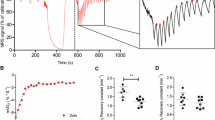Abstract
The purpose of this study was to compare rates of substrate oxidation in two protocols of intermittent exercise, with identical treadmill speed and total work duration, to reduce the effect of differences in factors such as muscle fibre type activation, hormonal responses, muscle glucose uptake and non-esterified fatty acid (NEFA) availability on the comparison of substrate utilisation. Subjects (n = 7) completed 40 min of intermittent intense running requiring a work:recovery ratio of either 6 s:9 s (short-interval exercise, SE) or 24 s:36 s (long-interval exercise, LE), on separate days. Another experiment compared O2 availability in the vastus lateralis muscle across SE (10 min) and LE (10 min) exercise using near-infrared spectroscopy (RunMan, NIM. Philadelphia, USA). Overall (i.e. work and recovery) O2 consumption (V˙O2) and energy expenditure were lower during LE (P < 0.01, P < 0.05, respectively). Overall exercise intensity, represented as a proportion of peak aerobic power (V˙O2peak), was [mean (SEM)] 64.9 (2.7)% V˙O2peak (LE) and 71.4 (2.4)% V˙O2peak (SE). Fat oxidation was three times lower (P < 0.01) and carbohydrate oxidation 1.3 times higher (P < 0.01) during LE, despite the lower overall exercise intensity. Plasma lactate was constant and was higher throughout exercise in LE [mean (SEM) 5.33 (0.53) mM, LE; 3.28 (0.31) mM, SE; P < 0.001)]. Plasma pyruvate was higher and glycerol was lower in LE [215 (17) μM, 151 (13) μM, P < 0.05, pyruvate; 197 (19) μM, 246 (19) μM, P < 0.05, glycerol]. There was no difference between protocols for plasma NEFA concentration (n = 4) or plasma noradrenaline and adrenaline. Muscle oxygenation declined in both protocols (P < 0.001), but the nadir during LE was lower [52.04 (0.60)%] compared to SE [61.85 (0.51)%; P < 0.001]. The decline in muscle oxygenation during work was correlated with mean lactate concentration (r = 0.68; P < 0.05; n = 12). Lower levels of fat oxidation occurred concurrent with accelerated carbohydrate metabolism, increases in lactate and pyruvate and reduced muscle O2 availability. These changes were associated with proportionately longer work and recovery periods, despite identical treadmill speed and total work duration. The proposal that a metabolic regulatory factor within the muscle fibre retards fat oxidation under these conditions is supported by the current findings.
Similar content being viewed by others
Author information
Authors and Affiliations
Additional information
Accepted: 14 April 1999
Rights and permissions
About this article
Cite this article
Christmass, M., Dawson, B. & Arthur, P. Effect of work and recovery duration on skeletal muscle oxygenation and fuel use during sustained intermittent exercise. Eur J Appl Physiol 80, 436–447 (1999). https://doi.org/10.1007/s004210050615
Issue Date:
DOI: https://doi.org/10.1007/s004210050615




